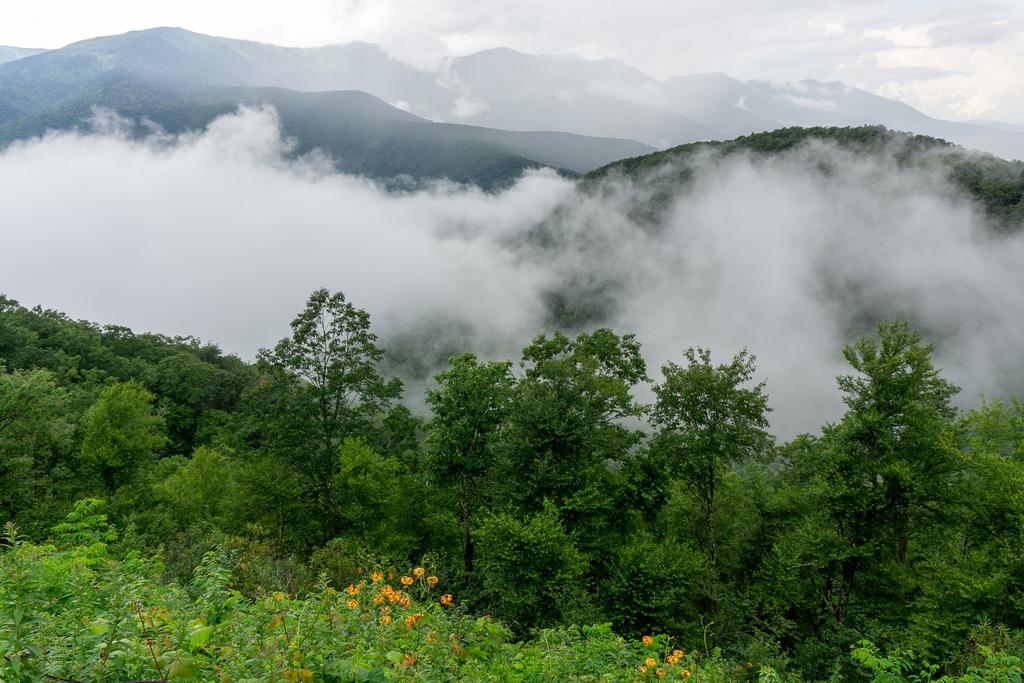Western North Carolina Physical Geography
The Mountains of Western North Carolina
Asheville, WNC's largest city (2020 pop. 93,350) is located in the French Broad River valley, which lies roughly in the center of North Carolina's Mountain region. The area is part of the southern Appalachian mountains, and the mountains in the region are the highest of the Appalachian chain. Although the peak elevations of the southern Appalachians aren't that impressive when compared to other world chains, they are easily 4,000 ft from base to top, and top out at nearly 7000 ft. Steep, rocky peaks are common as are trails that climb over 2000 ft.

In the Southern Appalachians, the area of high relief swells far beyond its average width and height further North. The Blue Ridge is a long, relatively low range of ridges along an escarpment, which separates the highlands from the Piedmont region of Western North Carolina. This ridge stretches from the southern border of NC with SC all the way to the northern border with VA, oriented in a SW to NE direction. Its summit is the Eastern Continental Divide. To the east of it, all streams flow to the Atlantic ocean. To the west of it, all streams flow into the Gulf of Mexico. The highest point on the Blue Ridge, Grandfather Mountain, reaches nearly 6000 ft. Most mountains in the range rise to around 3000-4000 ft, slightly higher in places.
Shorter ranges and clusters of mountains lie to the West of the long, even Blue Ridge - and they are generally the highest. The Nantahala Mountains, Snowbird Mountains, Great Smoky Mountains, Balsam Mountains, and Newfound Mountains lie to the Southwest of the French Broad River basin and occupy the lands in the extreme Southwest portion of the state. The French Broad River basin is a broad, hilly valley running northwest from near Brevard to the NC-TN line where it narrows into a gorge. Northwest of the French Broad River basin lies the Bald Mountains and the Black Mountains, which contain Mount Mitchell, the highest mountain east of the Mississippi. Even further northeast, along the NC-TN line, lies Roan Mountain and the North Carolina High Country - the area with the highest average elevation east of the Mississippi. This area is generally a high, rolling plateau.

Here are some major peaks and area elevations:
- City of Asheville - about 2200 feet.
- Town of Highlands - about 4500 feet (Highlands Plateau).
- Town of Beech Mountain - about 5500 feet (Mountain on the High Country Plateau).
- Looking Glass Rock - 3969 feet (Davidson River Area)
- Mount Pisgah - 5721 feet (Pisgah Ranger District - Pisgah Ridge)
- Grandfather Mountain
- Craggy Dome - 6085 feet (Great Craggy Mts. Area, near Craggy Gardens and the Black Mountains)
- Clingman's Dome - 6643 feet (highest in Great Smoky Mts. Area; highest in Tennessee on the NC-TN state line; 3rd highest in the east)
- Mount Mitchell - 6684 feet - (highest point east of the Mississippi River, in the Black Mountain range)
Physically Speaking: The Trails of Western North Carolina
The trails in our area have various and even predictable characteristics, yet each one holds its own surprises. For example, trails that follow old road or railroad beds all have similarities, and you can learn what to expect from a trail that follows a ridgeline, one that travels beside a stream, or one that travels along a mountainside. Even the type of forest a trail travels through indicates what you might find along the way. But the view you'll find around the next bend - that can never be predicted by looking at a map.
Most trails are hatched through thick vegetation of many kinds, depending on their location. You can expect trails that follow rivers and creeks, and that travel through coves, to have a wet, muddy, rocky, and maybe sandy surface. These trails will pass through ferns and other lush groundcover, tall hemlocks, cove hardwood forests (tuliptree is a common species), and thick Rosebay rhododendron, which blooms around June. Mountainside trails often follow old logging or skid road beds, which have now become singletrack, in forests of oaks, some cove hardwoods, and scattered mountain laurel and rhododendrons. Ridgetop trails are often dry and rocky, passing through laurel, Catawba rhododendron, and mixed hardwoods and pines. All trails can have rocks and roots.
Steep trail sections often have waterbars (logs) placed across the trails to keep erosion down. Many times though, the trails do erode and become shallow clay canyons. High elevation trails (rare) above 5000 feet are usually extremely wet or extremely dry and very rocky, with twisted northern hardwoods, lush heath shrubs (rhododendron, mountain laurel, and blueberry), and some scattered spruces and firs.
Other trail features include likely stream crossings and a wide variety of vegetation on any trail, wildlife (birds, bears, and deer are common), large rock outcroppings and boulders, open man-made meadows with tall grass (unless you are lucky enough and it has just been cut), lots of doubletrack and forest roads, and active logging areas.
Map Information
Download GPS Data
Click on a route, trail, or point on the map and select the GPS Data tab to download its data.
Data Formats
KML (Google Earth)
KML is the main file type used by Google Earth. If you have Google Earth installed, clicking the KML link should open the trail or point directly in Google Earth for viewing. This is the native file format used by Google Earth, but many other map applications can use and understand KML as well, so if you're not sure which one to download, KML is a good bet.
GPX
The GPX format stands for GPS Exchange - a free, open, XML format for exchanging GPS and map data. GPX is compatible with Google Earth, many other mapping programs, and most GPS devices (such as Garmin). Load the file directly into your GPS to help find your way on your next trip!
GeoJSON
GeoJSON is a newer, lightweight data exchange format which can be used to quickly share map data and may have a smaller size than KML or GPX. Many professional mapping and GIS applications support the GeoJSON format.
About the Map
Copyright
Base Layers
Base layers provided by OpenStreetMap, the US Geological Survey, the US Forest Service, and NC OneMap. Base layer images are subject to the respective copyright policies of their owners. Base layers may not be available at all times due to system maintenance or outages.
WNCOutdoors Base Layer
The WNCOutdoors Base layer is provided by WNCOutdoors.info. It is licensed by Creative Commons Attribution 3.0.
Trail and Marker Overlays
Trail layers and downloadable data are all original works created by WNCOutdoors with guidance from a variety of sources, including ensembles of our own GPS tracks, user contributed GPS tracks, official maps and GIS data from government agencies, and field observations. WNCOutdoors data is made freely available under the Open Database License - you are free to copy and use it for any purpose under the terms of that license (summary).
Tips
- Hover over a trail to see it highlighted. Helps to see start and end points for an individual trail.
- Scroll and zoom the map before printing, and that view will persist into the printed image.
- Click a trail for more details and to download it individually.


